Qing-Guo Chen
CHATS: Combining Human-Aligned Optimization and Test-Time Sampling for Text-to-Image Generation
Feb 18, 2025Abstract:Diffusion models have emerged as a dominant approach for text-to-image generation. Key components such as the human preference alignment and classifier-free guidance play a crucial role in ensuring generation quality. However, their independent application in current text-to-image models continues to face significant challenges in achieving strong text-image alignment, high generation quality, and consistency with human aesthetic standards. In this work, we for the first time, explore facilitating the collaboration of human performance alignment and test-time sampling to unlock the potential of text-to-image models. Consequently, we introduce CHATS (Combining Human-Aligned optimization and Test-time Sampling), a novel generative framework that separately models the preferred and dispreferred distributions and employs a proxy-prompt-based sampling strategy to utilize the useful information contained in both distributions. We observe that CHATS exhibits exceptional data efficiency, achieving strong performance with only a small, high-quality funetuning dataset. Extensive experiments demonstrate that CHATS surpasses traditional preference alignment methods, setting new state-of-the-art across various standard benchmarks.
Multi-Label Test-Time Adaptation with Bound Entropy Minimization
Feb 06, 2025



Abstract:Mainstream test-time adaptation (TTA) techniques endeavor to mitigate distribution shifts via entropy minimization for multi-class classification, inherently increasing the probability of the most confident class. However, when encountering multi-label instances, the primary challenge stems from the varying number of labels per image, and prioritizing only the highest probability class inevitably undermines the adaptation of other positive labels. To address this issue, we investigate TTA within multi-label scenario (ML--TTA), developing Bound Entropy Minimization (BEM) objective to simultaneously increase the confidence of multiple top predicted labels. Specifically, to determine the number of labels for each augmented view, we retrieve a paired caption with yielded textual labels for that view. These labels are allocated to both the view and caption, called weak label set and strong label set with the same size k. Following this, the proposed BEM considers the highest top-k predicted labels from view and caption as a single entity, respectively, learning both view and caption prompts concurrently. By binding top-k predicted labels, BEM overcomes the limitation of vanilla entropy minimization, which exclusively optimizes the most confident class. Across the MSCOCO, VOC, and NUSWIDE multi-label datasets, our ML--TTA framework equipped with BEM exhibits superior performance compared to the latest SOTA methods, across various model architectures, prompt initialization, and varying label scenarios. The code is available at https://github.com/Jinx630/ML-TTA.
Evaluating Image Caption via Cycle-consistent Text-to-Image Generation
Jan 08, 2025



Abstract:Evaluating image captions typically relies on reference captions, which are costly to obtain and exhibit significant diversity and subjectivity. While reference-free evaluation metrics have been proposed, most focus on cross-modal evaluation between captions and images. Recent research has revealed that the modality gap generally exists in the representation of contrastive learning-based multi-modal systems, undermining the reliability of cross-modality metrics like CLIPScore. In this paper, we propose CAMScore, a cyclic reference-free automatic evaluation metric for image captioning models. To circumvent the aforementioned modality gap, CAMScore utilizes a text-to-image model to generate images from captions and subsequently evaluates these generated images against the original images. Furthermore, to provide fine-grained information for a more comprehensive evaluation, we design a three-level evaluation framework for CAMScore that encompasses pixel-level, semantic-level, and objective-level perspectives. Extensive experiment results across multiple benchmark datasets show that CAMScore achieves a superior correlation with human judgments compared to existing reference-based and reference-free metrics, demonstrating the effectiveness of the framework.
MDP3: A Training-free Approach for List-wise Frame Selection in Video-LLMs
Jan 06, 2025Abstract:Video large language models (Video-LLMs) have made significant progress in understanding videos. However, processing multiple frames leads to lengthy visual token sequences, presenting challenges such as the limited context length cannot accommodate the entire video, and the inclusion of irrelevant frames hinders visual perception. Hence, effective frame selection is crucial. This paper emphasizes that frame selection should follow three key principles: query relevance, list-wise diversity, and sequentiality. Existing methods, such as uniform frame sampling and query-frame matching, do not capture all of these principles. Thus, we propose Markov decision determinantal point process with dynamic programming (MDP3) for frame selection, a training-free and model-agnostic method that can be seamlessly integrated into existing Video-LLMs. Our method first estimates frame similarities conditioned on the query using a conditional Gaussian kernel within the reproducing kernel Hilbert space~(RKHS). We then apply the determinantal point process~(DPP) to the similarity matrix to capture both query relevance and list-wise diversity. To incorporate sequentiality, we segment the video and apply DPP within each segment, conditioned on the preceding segment selection, modeled as a Markov decision process~(MDP) for allocating selection sizes across segments. Theoretically, MDP3 provides a \((1 - 1/e)\)-approximate solution to the NP-hard list-wise frame selection problem with pseudo-polynomial time complexity, demonstrating its efficiency. Empirically, MDP3 significantly outperforms existing methods, verifying its effectiveness and robustness.
UNIC-Adapter: Unified Image-instruction Adapter with Multi-modal Transformer for Image Generation
Dec 25, 2024



Abstract:Recently, text-to-image generation models have achieved remarkable advancements, particularly with diffusion models facilitating high-quality image synthesis from textual descriptions. However, these models often struggle with achieving precise control over pixel-level layouts, object appearances, and global styles when using text prompts alone. To mitigate this issue, previous works introduce conditional images as auxiliary inputs for image generation, enhancing control but typically necessitating specialized models tailored to different types of reference inputs. In this paper, we explore a new approach to unify controllable generation within a single framework. Specifically, we propose the unified image-instruction adapter (UNIC-Adapter) built on the Multi-Modal-Diffusion Transformer architecture, to enable flexible and controllable generation across diverse conditions without the need for multiple specialized models. Our UNIC-Adapter effectively extracts multi-modal instruction information by incorporating both conditional images and task instructions, injecting this information into the image generation process through a cross-attention mechanism enhanced by Rotary Position Embedding. Experimental results across a variety of tasks, including pixel-level spatial control, subject-driven image generation, and style-image-based image synthesis, demonstrate the effectiveness of our UNIC-Adapter in unified controllable image generation.
OmniEvalKit: A Modular, Lightweight Toolbox for Evaluating Large Language Model and its Omni-Extensions
Dec 09, 2024Abstract:The rapid advancements in Large Language Models (LLMs) have significantly expanded their applications, ranging from multilingual support to domain-specific tasks and multimodal integration. In this paper, we present OmniEvalKit, a novel benchmarking toolbox designed to evaluate LLMs and their omni-extensions across multilingual, multidomain, and multimodal capabilities. Unlike existing benchmarks that often focus on a single aspect, OmniEvalKit provides a modular, lightweight, and automated evaluation system. It is structured with a modular architecture comprising a Static Builder and Dynamic Data Flow, promoting the seamless integration of new models and datasets. OmniEvalKit supports over 100 LLMs and 50 evaluation datasets, covering comprehensive evaluations across thousands of model-dataset combinations. OmniEvalKit is dedicated to creating an ultra-lightweight and fast-deployable evaluation framework, making downstream applications more convenient and versatile for the AI community.
PEMF-VVTO: Point-Enhanced Video Virtual Try-on via Mask-free Paradigm
Dec 05, 2024



Abstract:Video Virtual Try-on aims to fluently transfer the garment image to a semantically aligned try-on area in the source person video. Previous methods leveraged the inpainting mask to remove the original garment in the source video, thus achieving accurate garment transfer on simple model videos. However, when these methods are applied to realistic video data with more complex scene changes and posture movements, the overly large and incoherent agnostic masks will destroy the essential spatial-temporal information of the original video, thereby inhibiting the fidelity and coherence of the try-on video. To alleviate this problem, we propose a novel point-enhanced mask-free video virtual try-on framework (PEMF-VVTO). Specifically, we first leverage the pre-trained mask-based try-on model to construct large-scale paired training data (pseudo-person samples). Training on these mask-free data enables our model to perceive the original spatial-temporal information while realizing accurate garment transfer. Then, based on the pre-acquired sparse frame-cloth and frame-frame point alignments, we design the point-enhanced spatial attention (PSA) and point-enhanced temporal attention (PTA) to further improve the try-on accuracy and video coherence of the mask-free model. Concretely, PSA explicitly guides the garment transfer to desirable locations through the sparse semantic alignments of video frames and cloth. PTA exploits the temporal attention on sparse point correspondences to enhance the smoothness of generated videos. Extensive qualitative and quantitative experiments clearly illustrate that our PEMF-VVTO can generate more natural and coherent try-on videos than existing state-of-the-art methods.
Meissonic: Revitalizing Masked Generative Transformers for Efficient High-Resolution Text-to-Image Synthesis
Oct 10, 2024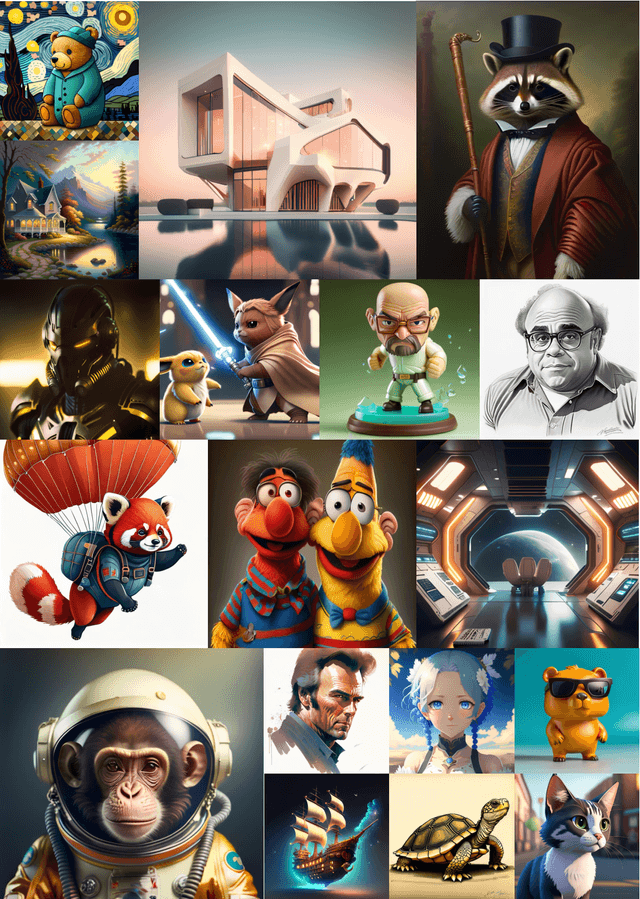
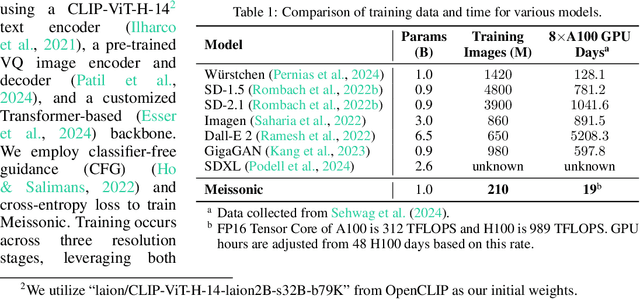

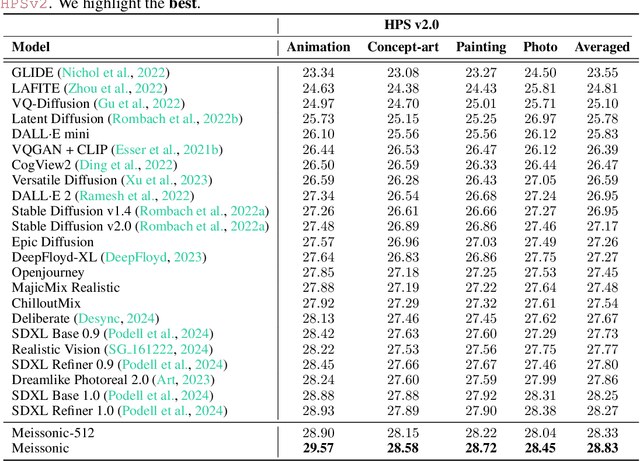
Abstract:Diffusion models, such as Stable Diffusion, have made significant strides in visual generation, yet their paradigm remains fundamentally different from autoregressive language models, complicating the development of unified language-vision models. Recent efforts like LlamaGen have attempted autoregressive image generation using discrete VQVAE tokens, but the large number of tokens involved renders this approach inefficient and slow. In this work, we present Meissonic, which elevates non-autoregressive masked image modeling (MIM) text-to-image to a level comparable with state-of-the-art diffusion models like SDXL. By incorporating a comprehensive suite of architectural innovations, advanced positional encoding strategies, and optimized sampling conditions, Meissonic substantially improves MIM's performance and efficiency. Additionally, we leverage high-quality training data, integrate micro-conditions informed by human preference scores, and employ feature compression layers to further enhance image fidelity and resolution. Our model not only matches but often exceeds the performance of existing models like SDXL in generating high-quality, high-resolution images. Extensive experiments validate Meissonic's capabilities, demonstrating its potential as a new standard in text-to-image synthesis. We release a model checkpoint capable of producing $1024 \times 1024$ resolution images.
Advancing Tool-Augmented Large Language Models: Integrating Insights from Errors in Inference Trees
Jun 11, 2024Abstract:Tool-augmented large language models (LLMs) leverage tools, often in the form of APIs, to enhance their reasoning capabilities on complex tasks, thus taking on the role of intelligent agents interacting with the real world. The recently introduced ToolLLaMA model by Qin et al. [2024] utilizes the depth-first search-based decision tree (DFSDT) method for reasoning with $16000+$ real-world APIs, which effectively improves the planning and inferencing performance of tool-augmented LLMs compared to traditional chain reasoning approaches. However, their approach only employs successful paths from decision trees (also called inference trees) for supervised fine-tuning (SFT) during training, which does not fully exploit the advantages of the tree of thought. In this study, we propose an inference trajectory optimization framework based on the preference data extracted from decision trees to address this limitation. We first introduce a novel method for constructing preference data from the tree of thought, capitalizing on the failed explorations previously overlooked in the trees. Specifically, we generate an effective step-wise preference dataset, named ToolPreference, for tool use based on the ToolBench dataset. In the subsequent training phase, we first fine-tune the LLM with tool-usage expert trajectories and then use these step-wise preference pairs for direct preference optimization (DPO) to update the policy of the LLM, resulting in our ToolPrefer-LLaMA (TP-LLaMA) model. Our experiments demonstrate that by obtaining insights from errors in inference trees, TP-LLaMA significantly outperforms the baselines across almost all test scenarios by a large margin and exhibits better generalization capabilities with unseen APIs. At the same time, TP-LLaMA has also demonstrated superior reasoning efficiency compared to the baselines, making it more suitable for complex tool-usage reasoning tasks.
Wings: Learning Multimodal LLMs without Text-only Forgetting
Jun 05, 2024
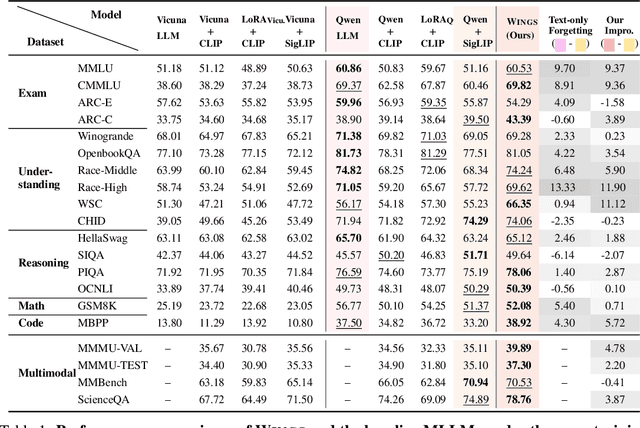
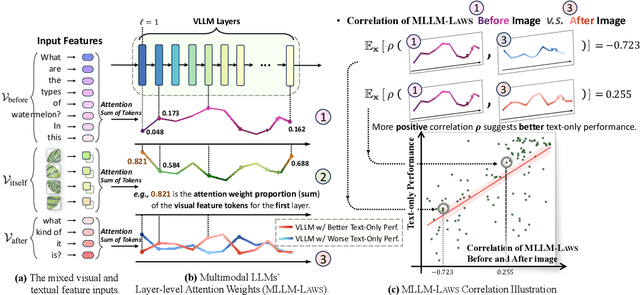
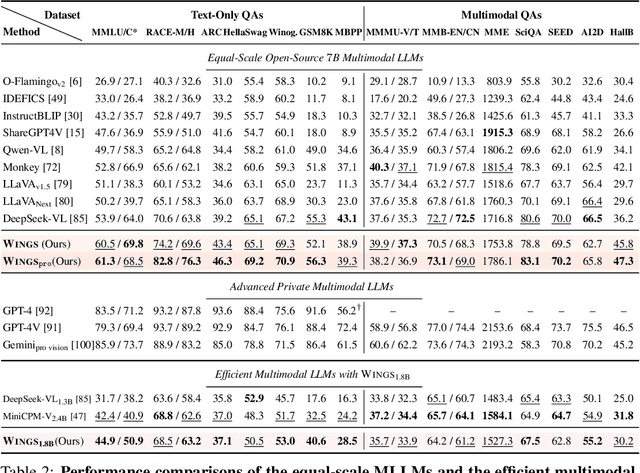
Abstract:Multimodal large language models (MLLMs), initiated with a trained LLM, first align images with text and then fine-tune on multimodal mixed inputs. However, the MLLM catastrophically forgets the text-only instructions, which do not include images and can be addressed within the initial LLM. In this paper, we present Wings, a novel MLLM that excels in both text-only dialogues and multimodal comprehension. Analyzing MLLM attention in multimodal instructions reveals that text-only forgetting is related to the attention shifts from pre-image to post-image text. From that, we construct extra modules that act as the boosted learner to compensate for the attention shift. The complementary visual and textual learners, like "wings" on either side, are connected in parallel within each layer's attention block. Initially, image and text inputs are aligned with visual learners operating alongside the main attention, balancing focus on visual elements. Textual learners are later collaboratively integrated with attention-based routing to blend the outputs of the visual and textual learners. We design the Low-Rank Residual Attention (LoRRA) to guarantee high efficiency for learners. Our experimental results demonstrate that Wings outperforms equally-scaled MLLMs in both text-only and visual question-answering tasks. On a newly constructed Interleaved Image-Text (IIT) benchmark, Wings exhibits superior performance from text-only-rich to multimodal-rich question-answering tasks.
 Add to Chrome
Add to Chrome Add to Firefox
Add to Firefox Add to Edge
Add to Edge